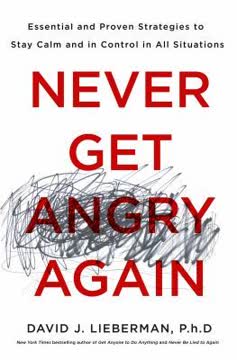Key Takeaways
1. Recognize the different types of rage and their root causes
Rage can be defined as an experience of excessive anger accompanied by partial or complete loss of conscious awareness, a normal sense of self, and/or behavioral control.
Types of rage: Sudden rage, seething rage, survival rage, impotent rage, shame-based rage, and abandonment rage. Each type stems from different emotional triggers and psychological needs. Sudden rage erupts quickly and unexpectedly, while seething rage builds slowly over time. Survival rage is rooted in past trauma, impotent rage in feelings of powerlessness, shame-based rage in deep-seated insecurity, and abandonment rage in fear of rejection.
Root causes: Rage often develops from:
- Childhood experiences of abuse, neglect, or inconsistent caregiving
- Traumatic events that overwhelm coping mechanisms
- Neurological imbalances or brain injuries
- Substance abuse or medication side effects
- Learned behavior from family or cultural influences
- Chronic stress or unresolved emotional issues
2. Understand the neurological basis of rage and its impact on behavior
The amygdala is your emotional warning center. Its job is to yell out "Danger, danger, danger!" within your brain and body.
Brain structures involved: The limbic system, particularly the amygdala and hippocampus, play crucial roles in emotional regulation and threat detection. In individuals prone to rage, these structures may be overactive or imbalanced, leading to exaggerated threat responses.
Neurochemical factors:
- Serotonin deficiency can increase aggression and impulsivity
- Excess dopamine may trigger violent outbursts
- Hormonal imbalances, such as elevated testosterone or fluctuating estrogen levels, can contribute to rage
Behavioral impact: Rage episodes often involve:
- Loss of conscious awareness or memory blackouts
- Altered sense of self or feeling "taken over" by anger
- Impaired judgment and decision-making abilities
- Extreme verbal or physical aggression
- Difficulty de-escalating once triggered
3. Identify personal rage patterns and triggers
The time to stop a seething rage from growing is always now. The earlier, the better: before the sense of your life being ruined gets locked into your brain, before your ongoing anger sucks the right out of your life.
Self-reflection: Examine your rage history, including frequency, intensity, and specific situations that trigger outbursts. Keep a rage journal to track patterns and identify common themes or triggers.
Common rage triggers:
- Perceived disrespect or criticism
- Feeling powerless or out of control
- Reminders of past trauma or abandonment
- Intense shame or humiliation
- Threats to important relationships
- Unmet expectations or frustrations
Personal vulnerabilities: Consider factors that may increase your susceptibility to rage, such as:
- History of trauma or abuse
- Substance abuse issues
- Underlying mental health conditions
- Chronic stress or sleep deprivation
- Poor emotional regulation skills
- Rigid thinking patterns or unrealistic expectations
4. Develop strategies to prevent sudden rages
Be hopeful. Believe that you can learn how to stop raging.
Cognitive techniques:
- Challenge distorted thoughts and misinterpretations of situations
- Practice mindfulness to increase awareness of emotional states
- Develop positive self-talk and affirmations to counteract rage-inducing thoughts
Behavioral strategies:
- Implement a "time-out" system to remove yourself from triggering situations
- Learn and practice relaxation techniques like deep breathing or progressive muscle relaxation
- Engage in regular exercise or physical activity to release tension
Environmental changes:
- Identify and avoid known rage triggers when possible
- Create a calm and supportive home environment
- Surround yourself with positive influences and supportive relationships
5. Learn techniques to manage seething rage and personal vendettas
Seething rages are festering wounds. The more you scratch at them, the more they bleed. The longer they last, the more damage they do.
Cognitive reframing: Challenge the narrative of victimhood and perceived injustices. Practice empathy and perspective-taking to understand others' motivations and reduce moral outrage.
Emotional processing:
- Journal about your feelings to gain insight and release pent-up emotions
- Practice forgiveness exercises to let go of grudges and resentments
- Engage in creative outlets to express and transform anger
Behavioral interventions:
- Set clear boundaries in relationships to address underlying issues
- Develop assertiveness skills to express needs and grievances effectively
- Engage in problem-solving activities to address legitimate concerns constructively
6. Address survival rage rooted in past trauma
Traumatized people sometimes get trapped in their pasts. It's like they're getting pulled into the black hole of their memories from which they'll never be able to escape.
Trauma-informed approach:
- Recognize the connection between past trauma and current rage reactions
- Work with a mental health professional to process traumatic experiences safely
- Learn grounding techniques to stay present during triggering situations
Neuroplasticity exercises:
- Practice mindfulness meditation to strengthen emotional regulation
- Engage in activities that promote brain health, such as learning new skills or solving puzzles
- Consider neurofeedback or other brain-training techniques under professional guidance
Building safety and trust:
- Create a network of safe, supportive relationships
- Develop a sense of physical and emotional safety in your environment
- Challenge hypervigilance and threat-detection biases through exposure therapy and cognitive restructuring
7. Overcome impotent rage by regaining a sense of control
Impotent rage is a feeling of tremendous fury that is triggered by the sense of helplessness that occurs when a person is unable to control important situations.
Identify areas of control:
- Focus on aspects of your life where you can exert influence
- Set realistic, achievable goals to build a sense of efficacy
- Practice decision-making skills in low-stakes situations
Acceptance strategies:
- Learn to differentiate between changeable and unchangeable circumstances
- Practice radical acceptance of situations beyond your control
- Develop resilience through adversity by reframing challenges as opportunities for growth
Empowerment techniques:
- Develop new skills or knowledge to increase your capabilities
- Engage in activities that promote self-efficacy and confidence
- Seek opportunities for leadership or mentorship in your community
8. Confront and heal shame-based rage
Shame-based rages happen when people cannot endure feeling their shame any longer. Instead, they go on the attack.
Self-compassion practices:
- Challenge negative self-talk and self-criticism
- Develop a kinder, more nurturing inner voice
- Engage in self-care activities that promote self-worth
Shame resilience:
- Identify and challenge core shame beliefs
- Share vulnerable experiences with trusted others to reduce shame's power
- Practice self-disclosure in safe environments to build authenticity
Building self-esteem:
- Set and achieve small, meaningful goals
- Celebrate personal strengths and accomplishments
- Engage in activities that align with your values and promote a sense of purpose
9. Manage abandonment rage through building secure attachments
Abandonment rage is a feeling of tremendous fury that is triggered by real or imagined threats of abandonment, betrayal, or neglect.
Attachment healing:
- Work with a therapist to understand and heal attachment wounds
- Practice self-soothing techniques to manage abandonment anxiety
- Develop a secure relationship with yourself through self-care and self-validation
Building relationship skills:
- Learn effective communication techniques to express needs and fears
- Practice setting healthy boundaries in relationships
- Develop trust gradually through consistent, reliable behavior
Emotional regulation:
- Recognize and name emotions related to abandonment fears
- Develop coping strategies for managing intense emotions without resorting to rage
- Practice tolerating uncertainty and ambiguity in relationships
By addressing these key aspects of rage, individuals can develop greater emotional intelligence, improve relationships, and lead more fulfilling lives free from the destructive power of uncontrolled anger.
Last updated:
FAQ
1. What is "Rage: A Step-by-Step Guide to Overcoming Explosive Anger" by Ronald T. Potter-Efron about?
- Comprehensive guide to rage: The book explores the nature, causes, and consequences of rage, distinguishing it from ordinary anger.
- Types and triggers of rage: It categorizes rage into different types, such as sudden, seething, survival, impotent, shame-based, and abandonment rage, and explains their unique triggers.
- Step-by-step interventions: Potter-Efron provides practical, actionable steps and exercises to help readers recognize, manage, and ultimately overcome explosive anger.
- For individuals and professionals: The book is designed for both people struggling with rage and the mental health professionals who support them.
2. Why should I read "Rage: A Step-by-Step Guide to Overcoming Explosive Anger" by Ronald T. Potter-Efron?
- Understand rage deeply: The book offers a nuanced understanding of rage, helping readers identify if and how it affects their lives.
- Practical tools for change: It provides concrete strategies, self-assessment questionnaires, and real-life examples to facilitate personal growth and emotional control.
- Addresses root causes: Potter-Efron delves into the psychological, neurological, and environmental origins of rage, making it easier to address the problem at its source.
- Empowers lasting change: The book emphasizes hope, commitment, and the possibility of living a life free from destructive anger.
3. What are the key takeaways from "Rage: A Step-by-Step Guide to Overcoming Explosive Anger"?
- Rage is distinct from anger: Rage involves excessive anger, loss of self-control, and often a sense of transformation or dissociation.
- Multiple types of rage: Understanding the six main types of rage (sudden, seething, survival, impotent, shame-based, abandonment) is crucial for effective intervention.
- Self-awareness is essential: Recognizing personal rage patterns, triggers, and early warning signs is the first step toward change.
- Change is possible: With commitment, support, and the right tools—including therapy, medication, and self-help strategies—rage can be managed and overcome.
4. How does Ronald T. Potter-Efron define "rage" in "Rage: A Step-by-Step Guide to Overcoming Explosive Anger"?
- Excessive anger and loss of control: Rage is defined as an experience of overwhelming anger that leads to partial or complete loss of conscious awareness, sense of self, and behavioral control.
- Transformative experience: During rage, individuals may feel like a different person, often acting in ways they later regret.
- Dissociative elements: Some rages involve "blackouts" or memory loss, where the person cannot recall their actions during the episode.
- Not just strong anger: Rage is more intense and destructive than even the strongest forms of ordinary anger.
5. What are the six main types of rage described in "Rage: A Step-by-Step Guide to Overcoming Explosive Anger"?
- Sudden rage: Rapid, unplanned, and intense anger episodes that often come without warning and result in loss of control.
- Seething rage: Long-term, simmering anger toward specific individuals or groups, often involving obsessive thoughts and fantasies of revenge.
- Survival rage: Triggered by real or perceived threats to physical safety, often rooted in past trauma or abuse.
- Impotent rage: Arises from feelings of helplessness and powerlessness in situations that seem uncontrollable.
- Shame-based rage: Erupts in response to feelings of embarrassment, criticism, or humiliation, often as a defense against deep-seated shame.
- Abandonment rage: Fueled by fears of rejection, betrayal, or neglect, typically rooted in early attachment issues.
6. What causes rage according to "Rage: A Step-by-Step Guide to Overcoming Explosive Anger" by Ronald T. Potter-Efron?
- Brain and biological factors: Imperfect brain wiring, neurotransmitter imbalances, and hormonal influences can predispose individuals to rage.
- Emotional trauma and stress: Past abuse, neglect, or overwhelming stress can damage emotional regulation systems, making rage more likely.
- Substance use and medications: Alcohol, drugs, and even some prescribed medications can lower inhibitions or trigger rage episodes.
- Learned behaviors and rewards: Modeling after parents or receiving payoffs for raging can reinforce rage patterns.
- Excessive shame and abandonment: Deep feelings of shame or repeated experiences of loss can fuel specific types of rage.
7. How can someone identify if they have a rage problem using "Rage: A Step-by-Step Guide to Overcoming Explosive Anger"?
- Self-assessment questionnaire: The book provides a detailed questionnaire covering indicators for each type of rage.
- Recognizing loss of control: Frequent episodes of blackouts, acting out of character, or inability to remember actions during anger are warning signs.
- Impact on life and relationships: If anger leads to broken relationships, legal trouble, or self-hatred, it may indicate a rage problem.
- Pattern recognition: Noticing recurring triggers, types of rage, and the inability to stop once anger starts are key identifiers.
8. What are the main strategies for overcoming sudden rage in "Rage: A Step-by-Step Guide to Overcoming Explosive Anger"?
- Hope and commitment: Believe that change is possible and make a strong commitment to work on rage control.
- Self-monitoring: Identify personal rage patterns, triggers, and early warning signs through reflection and journaling.
- Prevention and containment: Use anger management tools like time-outs, relaxation techniques, and disputing negative thoughts to prevent escalation.
- Support and medication: Build a support system, seek professional help, and consider medication if necessary for emotional regulation.
- Long-term healing: Address underlying issues such as insecurity, trauma, or self-esteem to create lasting change.
9. How does "Rage: A Step-by-Step Guide to Overcoming Explosive Anger" address seething rage and personal vendettas?
- Recognize the choice: Understand that holding onto resentment is a choice, and letting go is possible.
- Daily self-examination: Regularly check for growing resentments and address them before they become entrenched.
- Disputation and empathy: Challenge negative thoughts and practice empathy to reduce moral outrage and hatred.
- Letting go of hate: Use distraction, emotional indifference, forgiveness, or reconciliation to move past seething rage and regain peace of mind.
10. What advice does Ronald T. Potter-Efron give for managing survival rage and trauma-based anger?
- Question perceived danger: Learn to distinguish between real and imagined threats by challenging your brain’s threat assessments.
- Use calming phrases: Develop and practice simple, reassuring self-statements to interrupt the rage response.
- Seek safety and support: Surround yourself with safe people and, if possible, remove yourself from genuinely dangerous environments.
- Address trauma: Work with trusted friends or professionals to process past trauma and separate it from present experiences.
11. How does "Rage: A Step-by-Step Guide to Overcoming Explosive Anger" help with shame-based and abandonment rage?
- Identify underlying emotions: Recognize that rage may be masking deep shame or fear of abandonment.
- Challenge core beliefs: Replace negative self-messages (“I am not good enough”) with positive affirmations.
- Practice respect and trust: Treat others with dignity, seek out respectful relationships, and consciously choose to trust rather than accuse.
- Accept reassurance and let go: Learn to accept love and reassurance, and work to release past hurts through forgiveness or therapy.
12. What are the best quotes from "Rage: A Step-by-Step Guide to Overcoming Explosive Anger" by Ronald T. Potter-Efron and what do they mean?
- “Rage is an experience of excessive anger accompanied by partial or complete loss of conscious awareness, a normal sense of self, and/or behavioral control.”
- This defines rage as a transformative, overwhelming state that goes beyond ordinary anger.
- “Rages occur when you become angry enough at the world (or yourself) that you can no longer contain your anger through your usual channels.”
- Highlights the idea that rage is a breakdown of normal coping mechanisms.
- “You can stop raging. You can have a better life.”
- Emphasizes hope and the possibility of change, a central theme of the book.
- “The key to prevention is to gain a sense of personal control.”
- Suggests that empowerment and self-management are crucial to overcoming rage.
- “Forgiveness is allowing someone back into your heart.”
- Underscores the healing power of forgiveness in letting go of seething or impotent rage.
Review Summary
Rage by Ronald T. Potter-Efron receives positive reviews for its insightful analysis of different types of anger and practical advice on managing rage. Readers appreciate the book's categorization of rage types, helpful examples, and step-by-step methods for overcoming anger issues. Many find it life-changing and valuable for understanding their own anger or that of others. Some criticisms include dated language, gender stereotypes, and a lack of citations. Overall, readers recommend it for those struggling with anger management and those seeking to understand the topic better.
Similar Books









Download PDF
Download EPUB
.epub digital book format is ideal for reading ebooks on phones, tablets, and e-readers.





